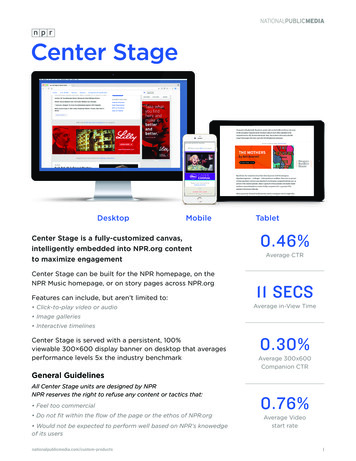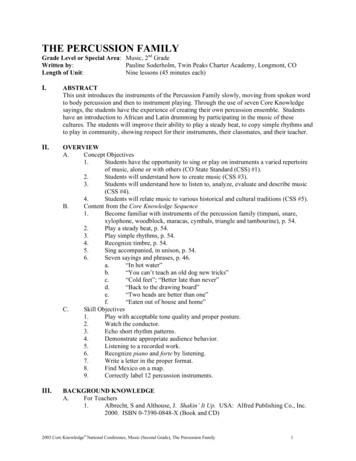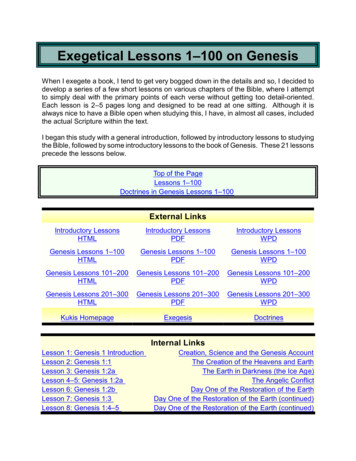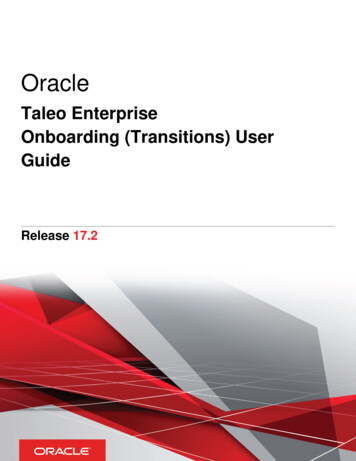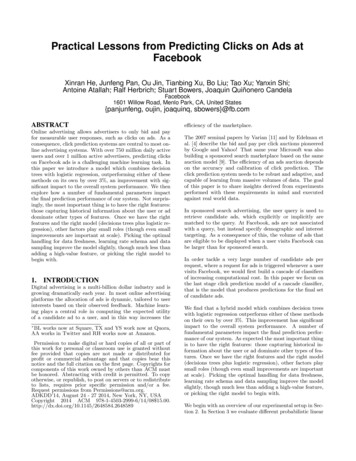
Transcription
Practical Lessons from Predicting Clicks on Ads atFacebookXinran He, Junfeng Pan, Ou Jin, Tianbing Xu, Bo Liu , Tao Xu , Yanxin Shi ,Antoine Atallah , Ralf Herbrich , Stuart Bowers, Joaquin Quiñonero CandelaFacebook1601 Willow Road, Menlo Park, CA, United States{panjunfeng, oujin, joaquinq, sbowers}@fb.comABSTRACTOnline advertising allows advertisers to only bid and payfor measurable user responses, such as clicks on ads. As aconsequence, click prediction systems are central to most online advertising systems. With over 750 million daily activeusers and over 1 million active advertisers, predicting clickson Facebook ads is a challenging machine learning task. Inthis paper we introduce a model which combines decisiontrees with logistic regression, outperforming either of thesemethods on its own by over 3%, an improvement with significant impact to the overall system performance. We thenexplore how a number of fundamental parameters impactthe final prediction performance of our system. Not surprisingly, the most important thing is to have the right features:those capturing historical information about the user or addominate other types of features. Once we have the rightfeatures and the right model (decisions trees plus logistic regression), other factors play small roles (though even smallimprovements are important at scale). Picking the optimalhandling for data freshness, learning rate schema and datasampling improve the model slightly, though much less thanadding a high-value feature, or picking the right model tobegin with.1.INTRODUCTIONDigital advertising is a multi-billion dollar industry and isgrowing dramatically each year. In most online advertisingplatforms the allocation of ads is dynamic, tailored to userinterests based on their observed feedback. Machine learning plays a central role in computing the expected utilityof a candidate ad to a user, and in this way increases the BL works now at Square, TX and YS work now at Quora,AA works in Twitter and RH works now at Amazon.Permission to make digital or hard copies of all or part ofthis work for personal or classroom use is granted withoutfee provided that copies are not made or distributed forprofit or commercial advantage and that copies bear thisnotice and the full citation on the first page. Copyrights forcomponents of this work owned by others than ACM mustbe honored. Abstracting with credit is permitted. To copyotherwise, or republish, to post on servers or to redistributeto lists, requires prior specific permission and/or a fee.Request permissions from Permissions@acm.org.ADKDD’14, August 24 - 27 2014, New York, NY, USACopyright 2014 ACM 978-1-4503-2999-6/14/08 iciency of the marketplace.The 2007 seminal papers by Varian [11] and by Edelman etal. [4] describe the bid and pay per click auctions pioneeredby Google and Yahoo! That same year Microsoft was alsobuilding a sponsored search marketplace based on the sameauction model [9]. The efficiency of an ads auction dependson the accuracy and calibration of click prediction. Theclick prediction system needs to be robust and adaptive, andcapable of learning from massive volumes of data. The goalof this paper is to share insights derived from experimentsperformed with these requirements in mind and executedagainst real world data.In sponsored search advertising, the user query is used toretrieve candidate ads, which explicitly or implicitly arematched to the query. At Facebook, ads are not associatedwith a query, but instead specify demographic and interesttargeting. As a consequence of this, the volume of ads thatare eligible to be displayed when a user visits Facebook canbe larger than for sponsored search.In order tackle a very large number of candidate ads perrequest, where a request for ads is triggered whenever a uservisits Facebook, we would first build a cascade of classifiersof increasing computational cost. In this paper we focus onthe last stage click prediction model of a cascade classifier,that is the model that produces predictions for the final setof candidate ads.We find that a hybrid model which combines decision treeswith logistic regression outperforms either of these methodson their own by over 3%. This improvement has significantimpact to the overall system performance. A number offundamental parameters impact the final prediction performance of our system. As expected the most important thingis to have the right features: those capturing historical information about the user or ad dominate other types of features. Once we have the right features and the right model(decisions trees plus logistic regression), other factors playsmall roles (though even small improvements are importantat scale). Picking the optimal handling for data freshness,learning rate schema and data sampling improve the modelslightly, though much less than adding a high-value feature,or picking the right model to begin with.We begin with an overview of our experimental setup in Section 2. In Section 3 we evaluate different probabilistic linear
classifiers and diverse online learning algorithms. In the context of linear classification we go on to evaluate the impactof feature transforms and data freshness. Inspired by thepractical lessons learned, particularly around data freshnessand online learning, we present a model architecture that incorporates an online learning layer, whilst producing fairlycompact models. Section 4 describes a key component required for the online learning layer, the online joiner, anexperimental piece of infrastructure that can generate a livestream of real-time training data.Lastly we present ways to trade accuracy for memory andcompute time and to cope with massive amounts of trainingdata. In Section 5 we describe practical ways to keep memory and latency contained for massive scale applications andin Section 6 we delve into the tradeoff between training datavolume and accuracy.2.EXPERIMENTAL SETUPIn order to achieve rigorous and controlled experiments, weprepared offline training data by selecting an arbitrary weekof the 4th quarter of 2013. In order to maintain the sametraining and testing data under different conditions, we prepared offline training data which is similar to that observedonline. We partition the stored offline data into training andtesting and use them to simulate the streaming data for online training and prediction. The same training/testing dataare used as testbed for all the experiments in the paper.Evaluation metrics: Since we are most concerned withthe impact of the factors to the machine learning model,we use the accuracy of prediction instead of metrics directlyrelated to profit and revenue. In this work, we use Normalized Entropy (NE) and calibration as our major evaluationmetric.Normalized Entropy or more accurately, Normalized CrossEntropy is equivalent to the average log loss per impressiondivided by what the average log loss per impression wouldbe if a model predicted the background click through rate(CTR) for every impression. In other words, it is the predictive log loss normalized by the entropy of the backgroundCTR. The background CTR is the average empirical CTRof the training data set. It would be perhaps more descriptive to refer to the metric as the Normalized LogarithmicLoss. The lower the value is, the better is the predictionmade by the model. The reason for this normalization isthat the closer the background CTR is to either 0 or 1, theeasier it is to achieve a better log loss. Dividing by the entropy of the background CTR makes the NE insensitive tothe background CTR. Assume a given training data set hasN examples with labels yi { 1, 1} and estimated probability of click pi where i 1, 2, .N . The average empiricalCTR as pPn1 yi1 yilog(1 pi )) N1i 1 ( 2 log(pi ) 2NE (p log(p) (1 p) log(1 p))(1)NE is essentially a component in calculating Relative Information Gain (RIG) and RIG 1 N EFigure 1: Hybrid model structure. Input featuresare transformed by means of boosted decision trees.The output of each individual tree is treated as acategorical input feature to a sparse linear classifier.Boosted decision trees prove to be very powerfulfeature transforms.Calibration is the ratio of the average estimated CTR andempirical CTR. In other words, it is the ratio of the numberof expected clicks to the number of actually observed clicks.Calibration is a very important metric since accurate andwell-calibrated prediction of CTR is essential to the successof online bidding and auction. The less the calibration differsfrom 1, the better the model is. We only report calibrationin the experiments where it is non-trivial.Note that, Area-Under-ROC (AUC) is also a pretty goodmetric for measuring ranking quality without consideringcalibration. In a realistic environment, we expect the prediction to be accurate instead of merely getting the optimal ranking order to avoid potential under-delivery or overdelivery. NE measures the goodness of predictions and implicitly reflects calibration. For example, if a model overpredicts by 2x and we apply a global multiplier 0.5 to fixthe calibration, the corresponding NE will be also improvedeven though AUC remains the same. See [12] for in-depthstudy on these metrics.3.PREDICTION MODEL STRUCTUREIn this section we present a hybrid model structure: theconcatenation of boosted decision trees and of a probabilistic sparse linear classifier, illustrated in Figure 1. In Section 3.1 we show that decision trees are very powerful inputfeature transformations, that significantly increase the accuracy of probabilistic linear classifiers. In Section 3.2 weshow how fresher training data leads to more accurate predictions. This motivates the idea to use an online learningmethod to train the linear classifier. In Section 3.3 we compare a number of online learning variants for two families ofprobabilistic linear classifiers.The online learning schemes we evaluate are based on the
Stochastic Gradient Descent (SGD) algorithm [2] applied tosparse linear classifiers. After feature transformation, anad impression is given in terms of a structured vector x (ei1 , . . . , ein ) where ei is the i-th unit vector and i1 , . . . , inare the values of the n categorical input features. In thetraining phase, we also assume that we are given a binarylabel y { 1, 1} indicating a click or no-click.Given a labeled ad impression (x, y), let us denote the linearcombination of active weights ass(y, x, w) y · wT x ynXwj,ij ,(2)j 1where w is the weight vector of the linear click score.In the state of the art Bayesian online learning scheme forprobit regression (BOPR) described in [7] the likelihood andprior are given by s(y, x, w),p(y x, w) Φβp(w) NYN (wk ; µk , σk2 ) ,k 1where Φ(t) is the cumulative density function of standardnormal distribution and N (t) is the density function of thestandard normal distribution. The online training is achievedthrough expectation propagation with moment matching.The resulting model consists of the mean and the varianceof the approximate posterior distribution of weight vectorw. The inference in the BOPR algorithm is to computep(w y, x) and project it back to the closest factorizing Gaussian approximation of p(w). Thus, the update algorithmcan be solely expressed in terms of update equations for allmeans and variances of the non-zero components x (see [7]): σi2js(y, x, µ)µi j µi j y ··v,(3)ΣΣ"# σi2js(y, x, µ)σi2j σi2j · 1 2 · w,(4)ΣΣΣ2 β2 nXσi2j .(5)j 1Here, the corrector functions v and w are given by v(t) : N (t)/Φ(t) and w(t) : v(t) · [v(t) t]. This inference can beviewed as an SGD scheme on the belief vectors µ and σ.is automatically controlled by the belief uncertainty σ. InSubsection 3.3 we will present various step-size functions ηand compare to BOPR.Both SGD-based LR and BOPR described above are streamlearners as they adapt to training data one by one.3.1Decision tree feature transformsThere are two simple ways to transform the input featuresof a linear classifier in order to improve its accuracy. Forcontinuous features, a simple trick for learning non-lineartransformations is to bin the feature and treat the bin index as a categorical feature. The linear classifier effectivelylearns a piece-wise constant non-linear map for the feature.It is important to learn useful bin boundaries, and there aremany information maximizing ways to do this.The second simple but effective transformation consists inbuilding tuple input features. For categorical features, thebrute force approach consists in taking the Cartesian product, i.e. in creating a new categorical feature that takesas values all possible values of the original features. Notall combinations are useful, and those that are not can bepruned out. If the input features are continuous, one can dojoint binning, using for example a k-d tree.We found that boosted decision trees are a powerful and veryconvenient way to implement non-linear and tuple transformations of the kind we just described. We treat each individual tree as a categorical feature that takes as value theindex of the leaf an instance ends up falling in. We use 1of-K coding of this type of features. For example, considerthe boosted tree model in Figure 1 with 2 subtrees, wherethe first subtree has 3 leafs and the second 2 leafs. If aninstance ends up in leaf 2 in the first subtree and leaf 1 insecond subtree, the overall input to the linear classifier willbe the binary vector [0, 1, 0, 1, 0], where the first 3 entriescorrespond to the leaves of the first subtree and last 2 tothose of the second subtree. The boosted decision trees weuse follow the Gradient Boosting Machine (GBM) [5], wherethe classic L2 -TreeBoost algorithm is used. In each learning iteration, a new tree is created to model the residualof previous trees. We can understand boosted decision treebased transformation as a supervised feature encoding thatconverts a real-valued vector into a compact binary-valuedvector. A traversal from root node to a leaf node representsa rule on certain features. Fitting a linear classifier on thebinary vector is essentially learning weights for the set ofrules. Boosted decision trees are trained in a batch manner.We compare BOPR to an SGD of the likelihood functionp(y x, w) sigmoid(s(y, x, w)) ,where sigmoid(t) exp(t)/(1 exp(t)). The resulting algorithm is often called Logistic Regression (LR). The inference in this model is computing the derivative of the loglikelihood and walk a per-coordinate depending step size inthe direction of this gradient:wij wij y · ηij · g(s(y, x, w)) ,(6)where g is the log-likelihood gradient for all non-zero components and given by g(s) : [y(y 1)/2 y · sigmoid(s)].Note that (3) can be seen as a per-coordinate gradient descent like (6) on the mean vector µ where the step-size ηijWe carry out experiments to show the effect of including treefeatures as inputs to the linear model. In this experimentwe compare two logistic regression models, one with tree feature transforms and the other with plain (non-transformed)features. We also use a boosted decision tree model only forcomparison. Table 1 shows the results.Tree feature transformations help decrease Normalized Entropy by more more than 3.4% relative to the NormalizedEntropy of the model with no tree transforms. This is avery significant relative improvement. For reference, a typical feature engineering experiment will shave off a coupleof tens of a percent of relative NE. It is interesting to see
Table 1: Logistic Regression (LR) and boosted decision trees (Trees) make a powerful combination. Weevaluate them by their Normalized Entropy (NE)relative to that of the Trees only model.Model Structure NE (relative to Trees only)LR Trees96.58%LR only99.43%Trees only100%(reference)such as number of examples for training, number of trees,number of leaves in each tree, cpu, memory, etc. It may takemore than 24 hours to build a boosting model with hundredsof trees from hundreds of millions of instances with a single core cpu. In a practical case, the training can be donewithin a few hours via sufficient concurrency in a multi-coremachine with large amount of memory for holding the wholetraining set. In the next section we consider an alternative.The boosted decision trees can be trained daily or every couple of days, but the linear classifier can be trained in nearreal-time by using some flavor of online learning.3.3Online linear classifierIn order to maximize data freshness, one option is to trainthe linear classifier online, that is, directly as the labelledad impressions arrive. In the upcoming Section 4 we descibe a piece of infrastructure that could generate real-timetraining data. In this section we evaluate several ways ofsetting learning rates for SGD-based online learning for logistic regression. We then compare the best variant to onlinelearning for the BOPR model.In terms of (6), we explore the following choices:Figure 2: Prediction accuracy as a function of thedelay between training and test set in days. Accuracy is expressed as Normalized Entropy relative tothe worst result, obtained for the trees-only modelwith a delay of 6 days.that the LR and Tree models used in isolation have comparable prediction accuracy (LR is a bit better), but that it istheir combination that yield an accuracy leap. The gain inprediction accuracy is significant; for reference, the majorityof feature engineering experiments only manage to decreaseNormalized Entropy by a fraction of a percentage.1. Per-coordinate learning rate: The learning rate for feature i at iteration t is set toαqP.ηt,i t2β j 1 j,iα, β are two tunable parameters (proposed in [8]).2. Per-weight square root learning rate:α,ηt,i nt,iwhere nt,i is the total training instances with featurei till iteration t.3. Per-weight learning rate:ηt,i 3.2Data freshnessClick prediction systems are often deployed in dynamic environments where the data distribution changes over time. Westudy the effect of training data freshness on predictive performance. To do this we train a model on one particular dayand test it on consecutive days. We run these experimentsboth for a boosted decision tree model, and for a logisiticregression model with tree-transformed input features.In this experiment we train on one day of data, and evaluateon the six consecutive days and compute the normalizedentropy on each. The results are shown on Figure 2.Prediction accuracy clearly degrades for both models as thedelay between training and test set increases. For both models it can been seen that NE can be reduced by approximately 1% by going from training weekly to training daily.These findings indicate that it is worth retraining on a dailybasis. One option would be to have a recurring daily job thatretrains the models, possibly in batch. The time needed toretrain boosted decision trees varies, depending on factorsα.nt,i4. Global learning rate:αηt,i .t5. Constant learning rate:ηt,i α.The first three schemes set learning rates individually perfeature. The last two use the same rate for all features. Allthe tunable parameters are optimized by grid search (optimadetailed in Table 2.)We lower bound the learning rates by 0.00001 for continuouslearning. We train and test LR models on same data withthe above learning rate schemes. The experiment results areshown in Figure 3.From the above result, SGD with per-coordinate learningrate achieves the best prediction accuracy, with a NE almost 5% lower than when using per weight learning rate,
Table 2: Learning rate parameterLearning rate schemaParametersPer-coordinateα 0.1, β 1.0Per-weight square rootα 0.01Per-weightα 0.01Globalα 0.01Constantα 0.0005adsRankerfeamodelsTrainertures{x, y}clicks {y}{x}OnlineJoinerFigure 4: Online Learning Data/Model Flows.data and evaluate the prediction performance on the nextday. The result is shown in Table 3.Table 3: Per-coordinate online LR versus BOPRModel TypeNE (relative to LR)LR100%(reference)BOPR99.82%Figure 3: Experiment result for different learningrate schmeas for LR with SGD. The X-axis corresponds to different learning rate scheme. Wedraw calibration on the left-hand side primary yaxis, while the normalized entropy is shown withthe right-hand side secondary y-axis.which performs worst. This result is in line with the conclusion in [8]. SGD with per-weight square root and constantlearning rate achieves similar and slightly worse NE. Theother two schemes are significant worse than the previousversions. The global learning rate fails mainly due to theimbalance of number of training instance on each features.Since each training instance may consist of different features, some popular features receive much more training instances than others. Under the global learning rate scheme,the learning rate for the features with fewer instances decreases too fast, and prevents convergence to the optimumweight. Although the per-weight learning rates scheme addresses this problem, it still fails because it decreases thelearning rate for all features too fast. Training terminatestoo early where the model converges to a sub-optimal point.This explains why this scheme has the worst performanceamong all the choices.It is interesting to note that the BOPR update equation(3) for the mean is most similar to per-coordinate learningrate version of SGD for LR. The effective learning rate forBOPR is specific to each coordinate, and depends on theposterior variance of the weight associated to each individualcoordinate, as well as the “surprise” of label given what themodel would have predicted [7].We carry out an experiment to compare the prediction performance of LR trained with per-coordinate SGD and BOPR.We train both LR and BOPR models on the same trainingPerhaps as one would expect, given the qualitative similarityof the update equations, BOPR and LR trained with SGDwith per-coordinate learning rate have very similar prediction performance in terms of both NE and also calibration(not shown in the table).One advantages of LR over BOPR is that the model sizeis half, given that there is only a weight associated to eachsparse feature value, rather than a mean and a variance. Depending on the implementation, the smaller model size maylead to better cache locality and thus faster cache lookup. Interms of computational expense at prediction time, the LRmodel only requires one inner product over the feature vector and the weight vector, while BOPR models needs twoinner products for both variance vector and mean vectorwith the feature vector.One important advantage of BOPR over LR is that being aBayesian formulation, it provides a full predictive distribution over the probability of click. This can be used to compute percentiles of the predictive distribution, which can beused for explore/exploit learning schemes [3].4.ONLINE DATA JOINERThe previous section established that fresher training dataresults in increased prediction accuracy. It also presented asimple model architecture where the linear classifier layer istrained online.This section introduces an experimental system that generates real-time training data used to train the linear classifier via online learning. We will refer to this system as the“online joiner” since the critical operation it does is to joinlabels (click/no-click) to training inputs (ad impressions) inan online manner. Similar infrastructure is used for streamlearning for example in the Google Advertising System [1].The online joiner outputs a real-time training data streamto an infrastructure called Scribe [10]. While the positive
labels (clicks) are well defined, there is no such thing as a“no click” button the user can press. For this reason, animpression is considered to have a negative no click label ifthe user did not click the ad after a fixed, and sufficientlylong period of time after seeing the ad. The length of thewaiting time window needs to be tuned carefully.Using too long a waiting window delays the real-time training data and increases the memory allocated to bufferingimpressions while waiting for the click signal. A too shorttime window causes some of the clicks to be lost, since thecorresponding impression may have been flushed out and labeled as non-clicked. This negatively affects “click coverage,”the fraction of all clicks successfully joined to impressions.As a result, the online joiner system must strike a balancebetween recency and click coverage.Not having full click coverage means that the real-time training set will be biased: the empirical CTR that is somewhatlower than the ground truth. This is because a fractionof the impressions labeled non-clicked would have been labeled as clicked if the waiting time had been long enough.In practice however, we found that it is easy to reduce thisbias to decimal points of a percentage with waiting windowsizes that result in manageable memory requirements. Inaddition, this small bias can be measured and corrected for.More study on the window size and efficiency can be foundat [6]. The online joiner is designed to perform a distributedstream-to-stream join on ad impressions and ad clicks utilizing a request ID as the primary component of the joinpredicate. A request ID is generated every time a user performs an action on Facebook that triggers a refresh of thecontent they are exposed to. A schematic data and modelflow for the online joiner consequent online learning is shownin Figure 4. The initial data stream is generated when a uservisits Facebook and a request is made to the ranker for candidate ads. The ads are passed back to the user’s deviceand in parallel each ad and the associated features used inranking that impression are added to the impression stream.If the user chooses to click the ad, that click will be addedto the click stream. To achieve the stream-to-stream jointhe system utilizes a HashQueue consisting of a First-InFirst-Out queue as a buffer window and a hash map for fastrandom access to label impressions. A HashQueue typicallyhas three kinds of operations on key-value pairs: enqueue,dequeue and lookup. For example, to enqueue an item, weadd the item to the front of a queue and create a key in thehash map with value pointing to the item of the queue.Only after the full join window has expired will the labelledimpression be emitted to the training stream. If no click wasjoined, it will be emitted as a negatively labeled example.In this experimental setup the trainer learns continuouslyfrom the training stream and publishes new models periodically to the Ranker. This ultimately forms a tight closedloop for the machine learning models where changes in feature distribution or model performance can be captured,learned on, and rectified in short succession.One important consideration when experimenting with areal-time training data generating system is the need tobuild protection mechanisms against anomalies that couldcorrupt the online learning system. Let us give a simpleexample. If the click stream becomes stale because of somedata infrastructure issue, the online joiner will produce training data that has a very small or even zero empirical CTR.As a consequence of this the real-time trainer will begin toincorrectly predict very low, or close to zero probabilities ofclick. The expected value of an ad will naturally depend onthe estimated probability of click, and one consequence ofincorrectly predicting very low CTR is that the system mayshow a reduced number of ad impressions. Anomaly detection mechanisms can help here. For example, one can automatically disconnect the online trainer from the online joinerif the real-time training data distribution changes abruptly.5. CONTAINING MEMORY AND LATENCY5.1 Number of boosting treesThe more trees in the model the longer the time required tomake a prediction. In this part, we study the effect of thenumber of boosted trees on estimation accuracy.We vary the number of trees from 1 to 2, 000 and train themodels on one full day of data, and test the prediction performance on the next day. We constrain that no more than12 leaves in each tree.Similar to previous experiments,we use normalized entropy as an evaluation metric. Theexperimental results are shown in Figure 5. Normalized en-Figure 5: Experiment result for number of boostingtrees. Different series corresponds to different submodels. The x-axis is the number of boosting trees.Y-axis is normalized entropy.tropy decreases as we increase the number of boosted trees.However, the gain from adding trees yields diminishing return. Almost all NE improvement comes from the first 500trees. The last 1, 000 trees decrease NE by less than 0.1%.Moreover, we see that the normalized entropy for submodel2 begins to regress after 1,000 trees. The reason for this phenomenon is overfitting. Since the training data for submodel2 is 4x smaller than that in submodel 0 and 1.5.2Boosting feature importanceFeature count is another model characteristic that can influence trade-offs between estimation accuracy and computation performance. To better understand the effect of featurecount we first apply a feature importance to each feature.In order to measure the importance of a feature we use thestatistic Boosting Feature Importance, which aims to cap-
ture the cumulative loss reduction attributable to a feature.In each tree node construction, a best feature is selected andsplit to maximize the squared error reduction. Since a feature can be used in multiple trees, the ( Boosting FeatureImportance) for each feature is determined by summing thetotal reduction for a specific feature across all trees.Typically, a small number of features contributes the majority of explanatory power while the remaining features haveonly a marginal contribution. We see this same patternwhen plotting the number of features versus their cumulative feature importance in Fig
retrieve candidate ads, which explicitly or implicitly are matched to the query. At Facebook, ads are not associated with a query, but instead specify demographic and interest targeting. As a consequence of this, the volume of ads that are eligible to be displayed when a user visits Facebook can be larger than for sponsored search.


